MARIANI’S
Virtual
Gourmet
May
15, 2016
NEWSLETTER
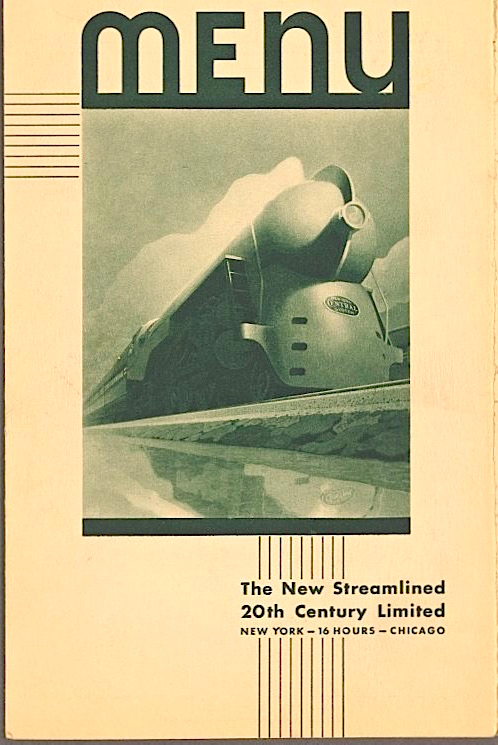
IN THIS ISSUE
ANNAPOLIS, Part One
By John Mariani
NEW YORK CORNER
LE PÉRIGORD
By John Mariani
NOTES FROM THE WINE CELLAR
TOP-NOTCH SICILIAN
WINES NOW AVAILABLE
By Geoff Kalish
❖❖❖
ANNAPOLIS, Part One
By John Mariani
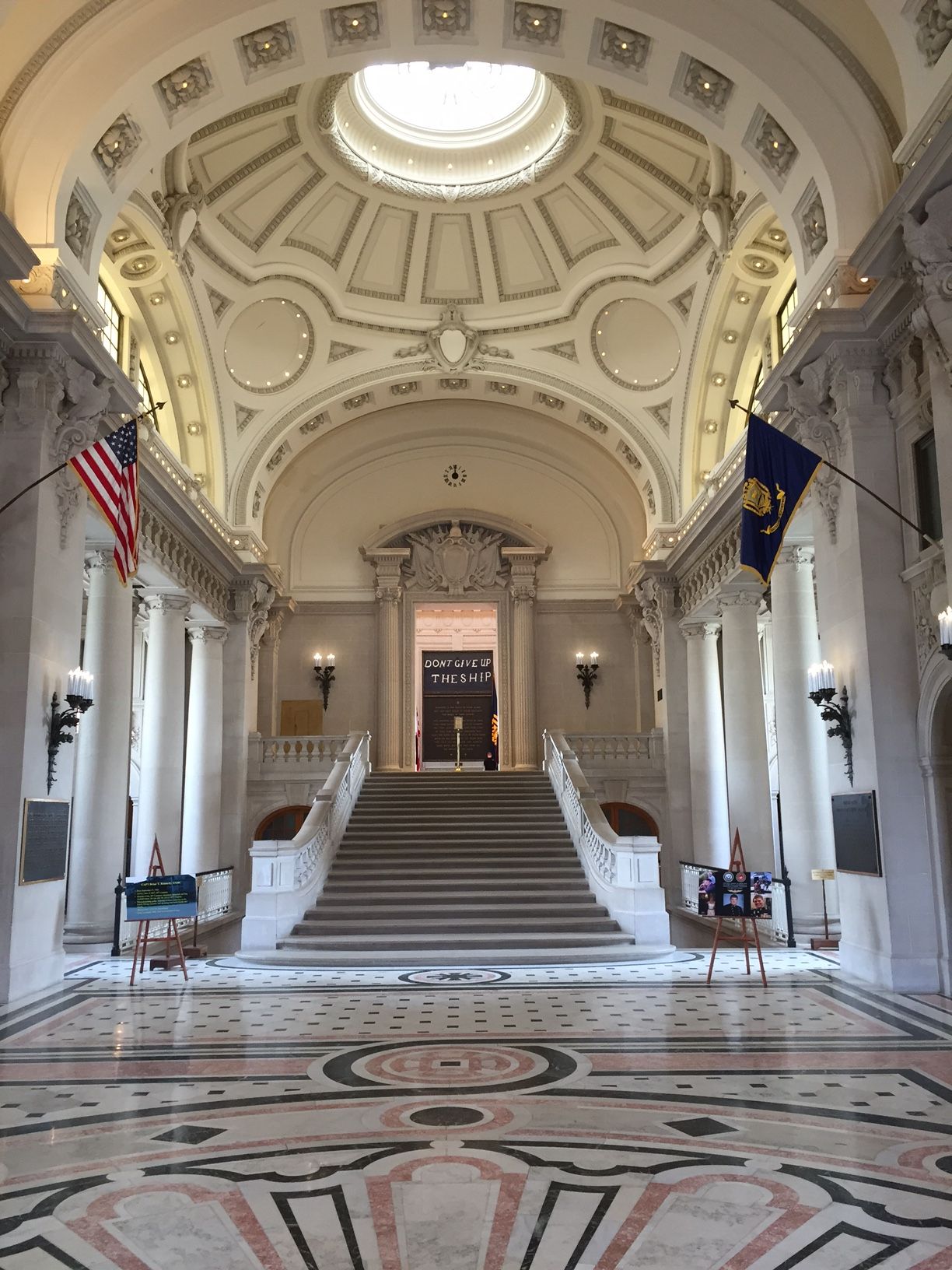
U.S. Naval Academy Bancroft Hall Dormitory, Annapolis MD
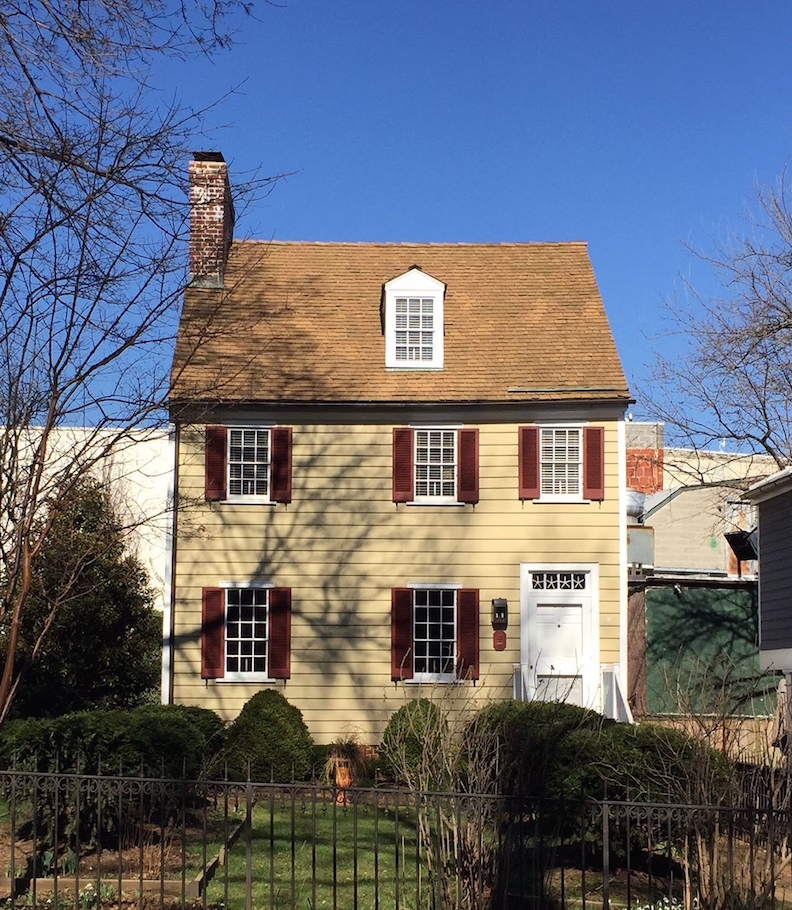 red brick Georgian
government buildings, including the
high-on-a-hill Maryland State House (below)--the
oldest capitol in continuous legislative use
since 1772; and the expansive buildings of the
sprawling U.S. Naval Academy, whose majestic
Chapel, which holds the crypt of John Paul
Jones, was dedicated in 1908. Everything
at the Academy has been enlarged and
modernized over the centuries.
red brick Georgian
government buildings, including the
high-on-a-hill Maryland State House (below)--the
oldest capitol in continuous legislative use
since 1772; and the expansive buildings of the
sprawling U.S. Naval Academy, whose majestic
Chapel, which holds the crypt of John Paul
Jones, was dedicated in 1908. Everything
at the Academy has been enlarged and
modernized over the centuries. There is history at every corner of the city. Annapolis was the nation's first peacetime capital of the new United States after the signing of the Treaty of Paris in 1783, ending the Revolutionary War, and where General George Washington resigned his commission
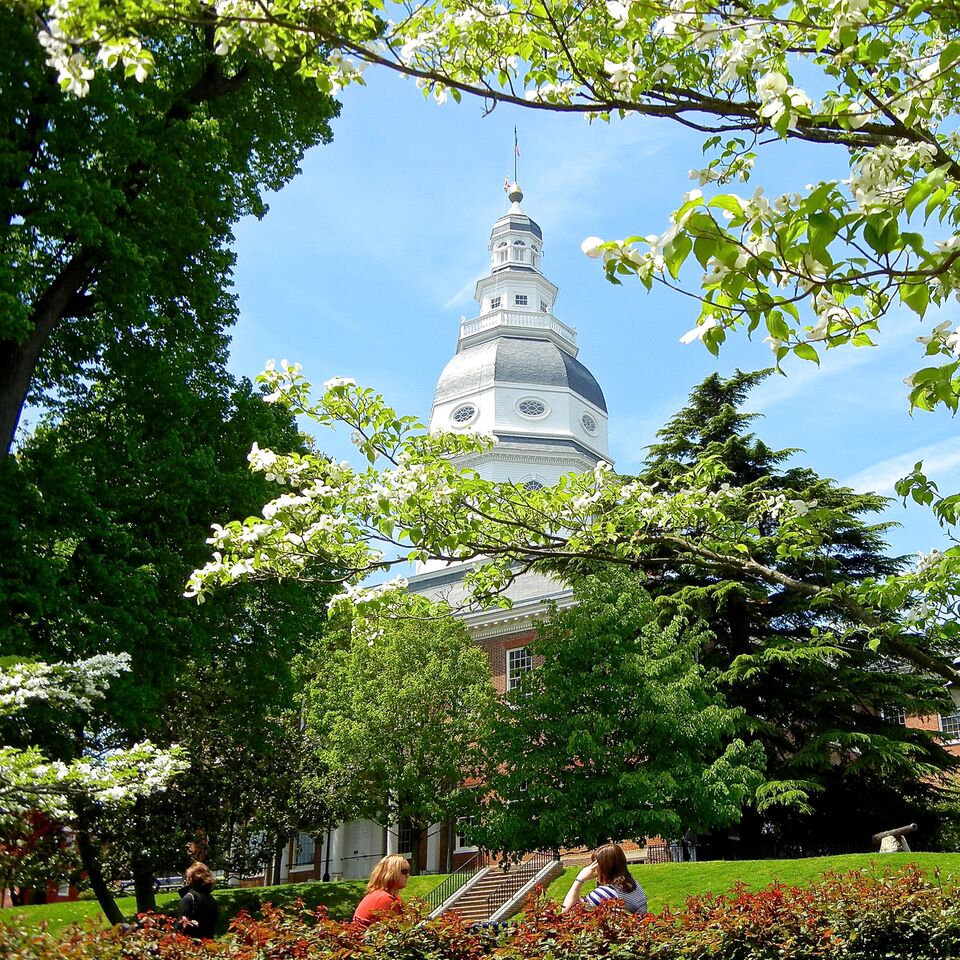 as commander-in-chief of the
Continental Army.
It was not until 1845 that the Naval Academy
was founded here, beginning with ten acres, now
spread over 338 impeccably maintained acres of
campus, classrooms, a vast sports center, and a
dormitory of daunting size and architectural Beaux
Art beauty; Bancroft Hall houses 4,000 midshipmen in
1,700 modern rooms, many appended to the original
design as recently as the 1960s.
as commander-in-chief of the
Continental Army.
It was not until 1845 that the Naval Academy
was founded here, beginning with ten acres, now
spread over 338 impeccably maintained acres of
campus, classrooms, a vast sports center, and a
dormitory of daunting size and architectural Beaux
Art beauty; Bancroft Hall houses 4,000 midshipmen in
1,700 modern rooms, many appended to the original
design as recently as the 1960s.It is thrilling to visit this exceptional campus--which they call "the Yard"-- to see the Midshipmen in their variously colored uniforms, men and women from every state, race, national background and creed, studying everything from mathematics, science, and liberal arts to the history of war and the strategies of generals going back to Alexander the Great. Their curriculum is in many ways tougher than at even the most prestigious universities, for aside from requirements to pass strenuous physical tests of strength and stamina, the Midshipmen must also maintain high academic standards. Many grads who are commissioned as officers. go into the Navy, some the Marines, others the air forces of those two arms. It is a difficult school to get into and tough to get through. Time off base is restricted. All must live by an honor code. No one pays tuition.
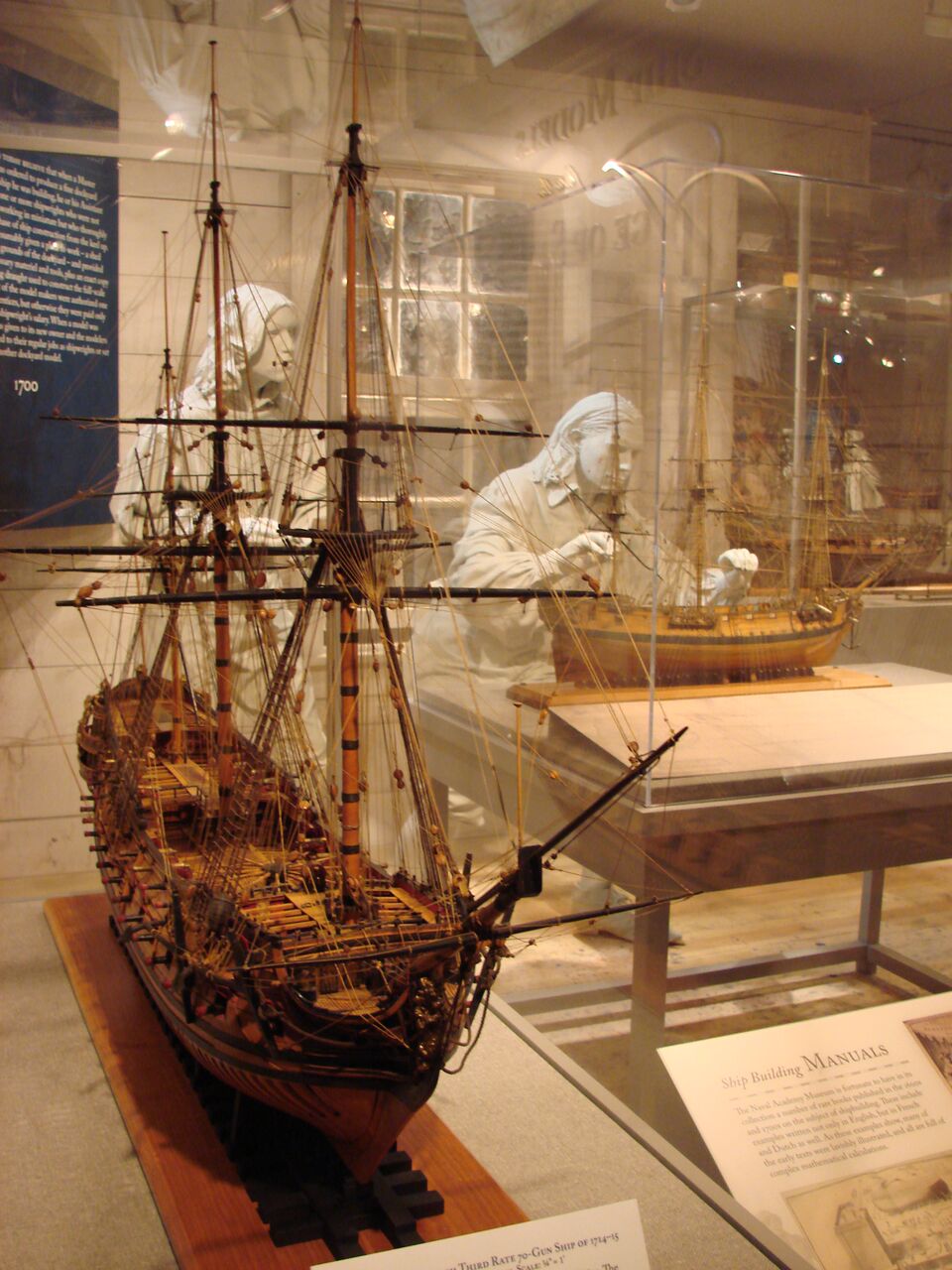 Preble
Hall (left)
houses the Naval Academy Museum, containing 6,000
prints depicting European and American naval history
from 1514 through World War II and one of the
world's best ship model collections, with many made
entirely of whalebone. Nimitz Hall is the Academy’s
library.
Preble
Hall (left)
houses the Naval Academy Museum, containing 6,000
prints depicting European and American naval history
from 1514 through World War II and one of the
world's best ship model collections, with many made
entirely of whalebone. Nimitz Hall is the Academy’s
library. Maryland was a border state and Annapolis was a Union stronghold during the Civil War so it suffered no damage, although 24% of the Naval Academy officers joined the Confederate cause, many serving in the South’s meager navy. As a result, many of the city’s colonial and ante-bellum houses still remain intact, with approved, color-coded plaques next to their doors explaining their role in the city’s history or what famous personage once lived there. Streets retain their 18th century English names—Duke of Gloucester, King George’s, Hanover—and, although the city lost most of its commercial maritime industry to Baltimore by the 1780s, this is still very much a port for recreational boating. Indeed, just a month ago the downtown port was completely renovated at a cost of $6.1 million, with a new seawall and widened boardwalk.
The city radiates out from the port, which is ringed with eateries, taverns, antique stores, and boutiques, including an LP record store and an old-fashioned barber shop, and there has always been a vibrant professional and community theater scene within the historic district, including the Colonial Players—its musical staging of “A Christmas Carol” is now an annual event— and the Annapolis Summer Garden presents outdoor productions each year. There is even a small Shakespeare company I managed to visit that was rehearsing Oscar Wilde’s “The Importance of Being Earnest.”
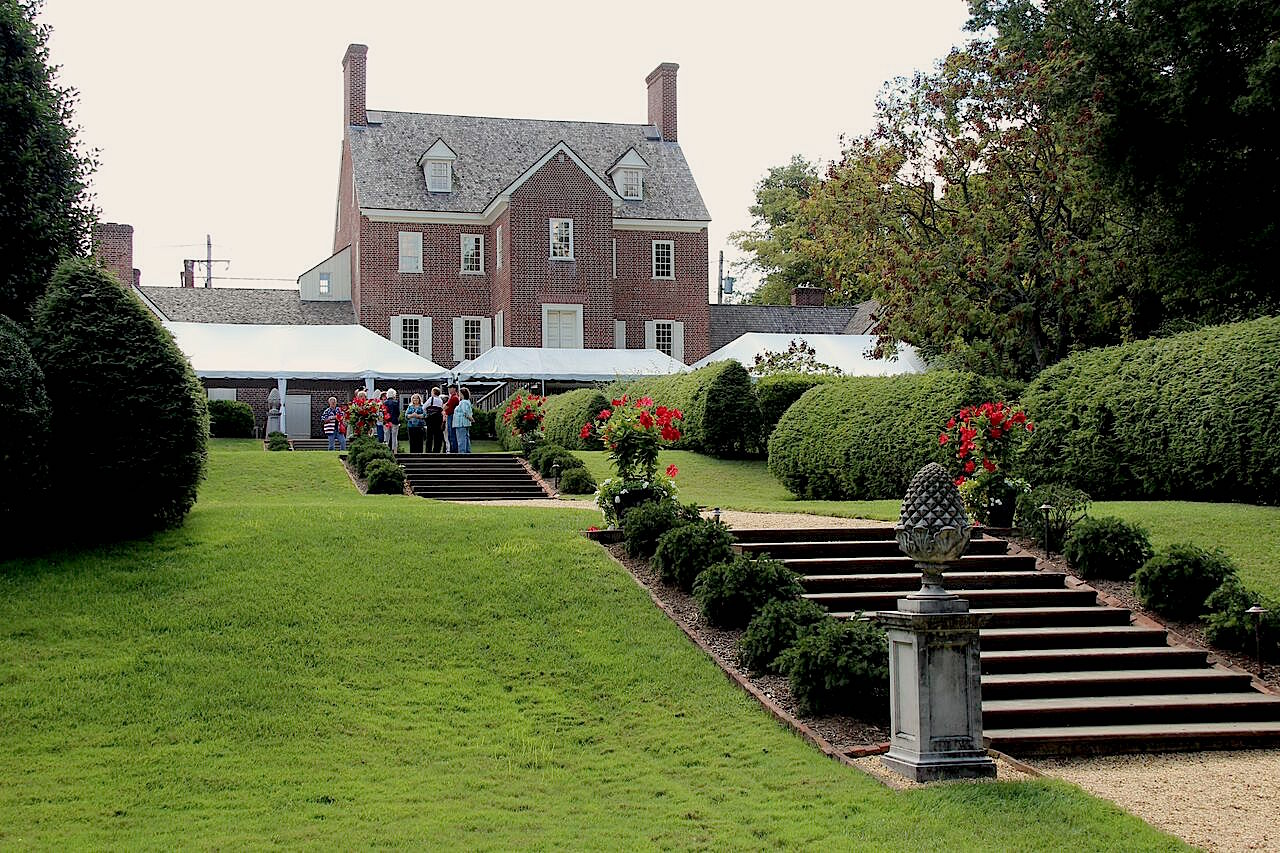
What I love best about the city, which I think of more as a large town, is that it’s so pleasingly walkable. It was not designed on some rigid grid pattern—from the air it looks like a maze—instead retaining centuries’ old narrow streets and corridors, mews and alleyways, some little more than cul-de-sacs, others that were once pathways for driven cattle. The round-abouts at Church Circle and State Circle slow everyone down to a civilized pace, and steepled churches pop out from unexpected places; there is also a memorial to Kunte Kinte, the real-life person who first set his shackled foot in America and was the inspiration for the slave hero of Alex Hailey’s novel Roots.
One of the most remarkable of the old mansions is the beautifully restored, five-part Georgian mansion called William Paca House and Garden (right), reclaimed from what was barely a shell of a 19th century entrance to a hotel and named after a signer of the Declaration of Independence. Today its impeccably reconstructed two acre garden grounds now frequently used for weddings and other celebrations.
One spot I almost overlooked is the Historic Annapolis Museum Store on Main Street, just across from the City Dock. Inside the solid brick structure is a shop full of souvenirs devoted to local craftspeople, and upstairs is a small but very impressive exhibit entitled “Freedom Bound:
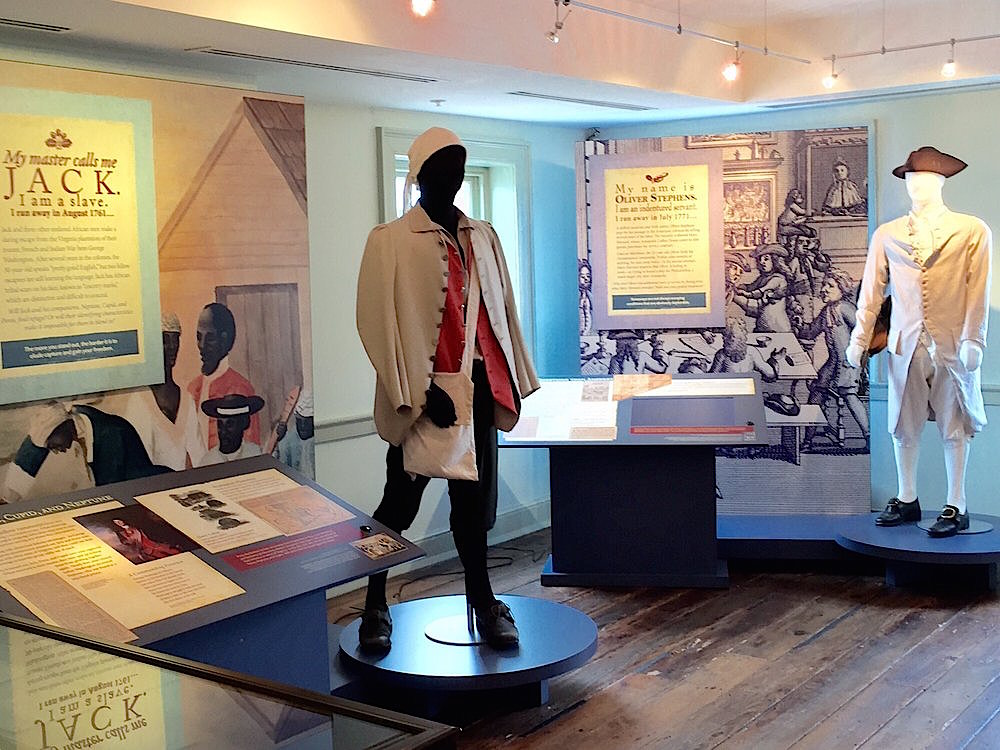 Runaways of
the Chesapeake” (left)
which relates the sad but inspiring stories of nine
servants and slaves who tried to escape bondage
between 1728 and 1864. Through documents taken from
the city’s Maryland
Gazette along with dramatic voices and visuals
to tell their tales, the people tell their stories
again, including the astonishing romance of an
Irish-American girl whose love for an escaped black
slave was so strong that, upon his capture, she
chose to join him on the slave plantation rather
than to live her life as a free woman without him.
Runaways of
the Chesapeake” (left)
which relates the sad but inspiring stories of nine
servants and slaves who tried to escape bondage
between 1728 and 1864. Through documents taken from
the city’s Maryland
Gazette along with dramatic voices and visuals
to tell their tales, the people tell their stories
again, including the astonishing romance of an
Irish-American girl whose love for an escaped black
slave was so strong that, upon his capture, she
chose to join him on the slave plantation rather
than to live her life as a free woman without him. You are never far from such echoes of history while walking the streets of Annapolis, cut into by the blue waters of the Chesapeake Bay, discovered by Giovanni da Verrazano in 1524. The Bay still flows for 200 miles to the Atlantic, that rough ocean so many of the city’s immigrants, many not by choice, once sailed so many centuries ago.
The city has a brand new website for travel info: VisitAnnapolis.org.
A VINOUS DIVERSION
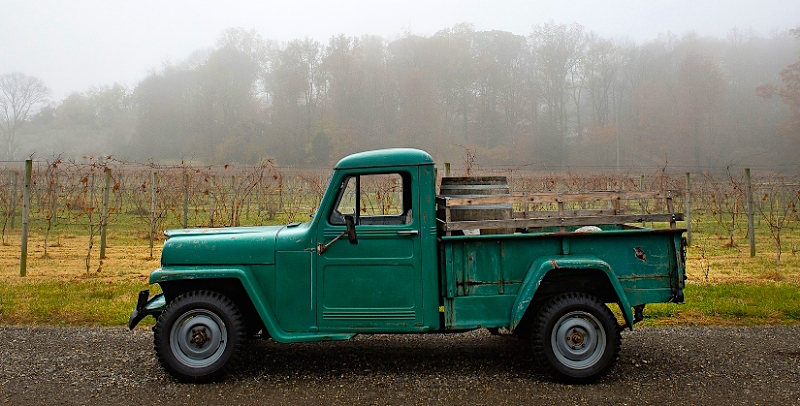 Just a
few miles outside of Annapolis' Historic District
is an enchanting little winery, Great Frogs
Vineyard, where, inside an
old tobacco barn house, you can schedule a tasting
of seven wines paired with artisan cheeses at $45
per person (without cheeses $25).
Just a
few miles outside of Annapolis' Historic District
is an enchanting little winery, Great Frogs
Vineyard, where, inside an
old tobacco barn house, you can schedule a tasting
of seven wines paired with artisan cheeses at $45
per person (without cheeses $25).
Set near the Chesapeake Bay on
land farmed since 1691, the vineyards have a
soil rich in oyster shells, and the proprietors
use all the grapes grown on the property (and buy
others) to make Bordeaux-style wines, like a
Limited Reserve Chardonnay at $30 and a Meritage
Reserve at $40. Expatriate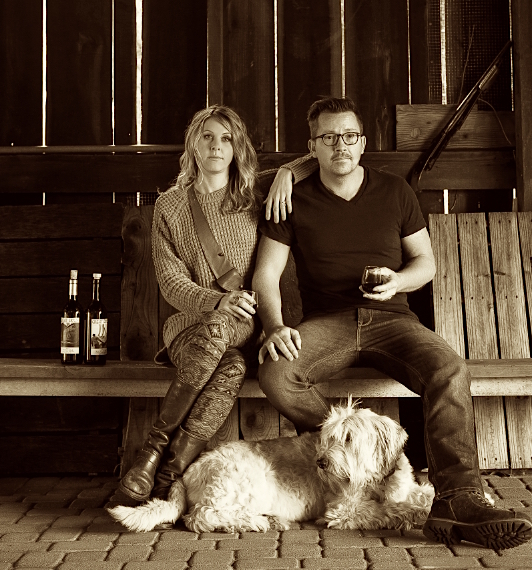 Californians Nathanael and Andrea
O'Shea (right,
with their dog Finn McCool) had
Midwest farming genes in their family, and,
without even knowing Maryland even had a wine
industry (there are 70 vineyards in the state),
they founded Great Frogs Vineyard in 1999, on land
where the cool Chesapeake breezes protect the
vines from the kind of frost, heat and humidity
otherwise found inland.
Californians Nathanael and Andrea
O'Shea (right,
with their dog Finn McCool) had
Midwest farming genes in their family, and,
without even knowing Maryland even had a wine
industry (there are 70 vineyards in the state),
they founded Great Frogs Vineyard in 1999, on land
where the cool Chesapeake breezes protect the
vines from the kind of frost, heat and humidity
otherwise found inland.
I found the wines to
be as impressive for their varietal character as
for the terroir they came from, proving that East
Coast wineries, whose history dates back to
colonial days, are quickly catching up to the
quality of the best coming out of the West Coast.
❖❖❖
By John Mariani
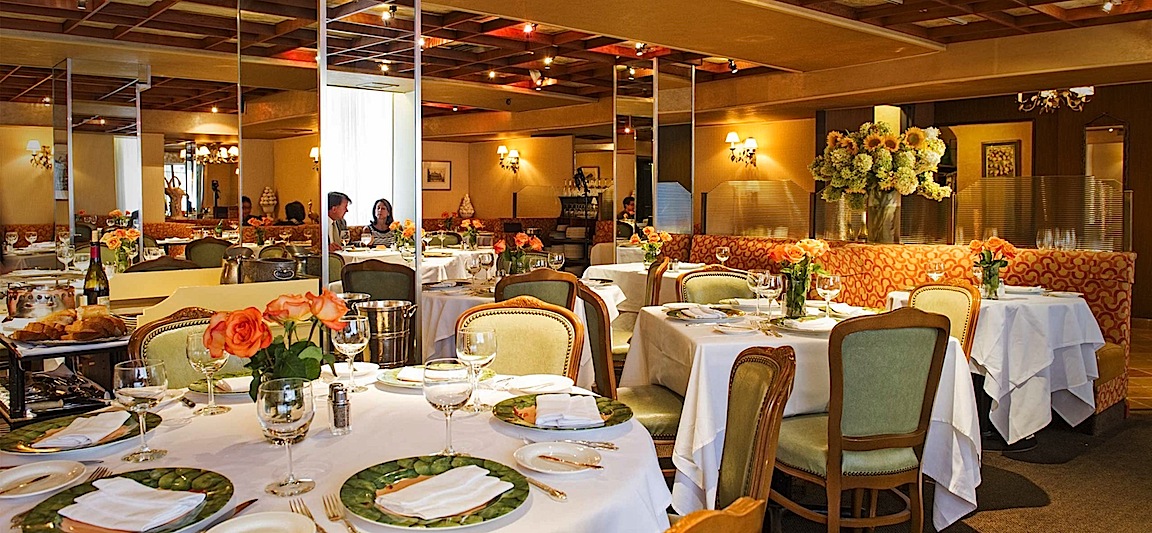
LE PÉRIGORD
405 East 52nd Street (near First Avenue)
212-755-6244
www.leperigord.com
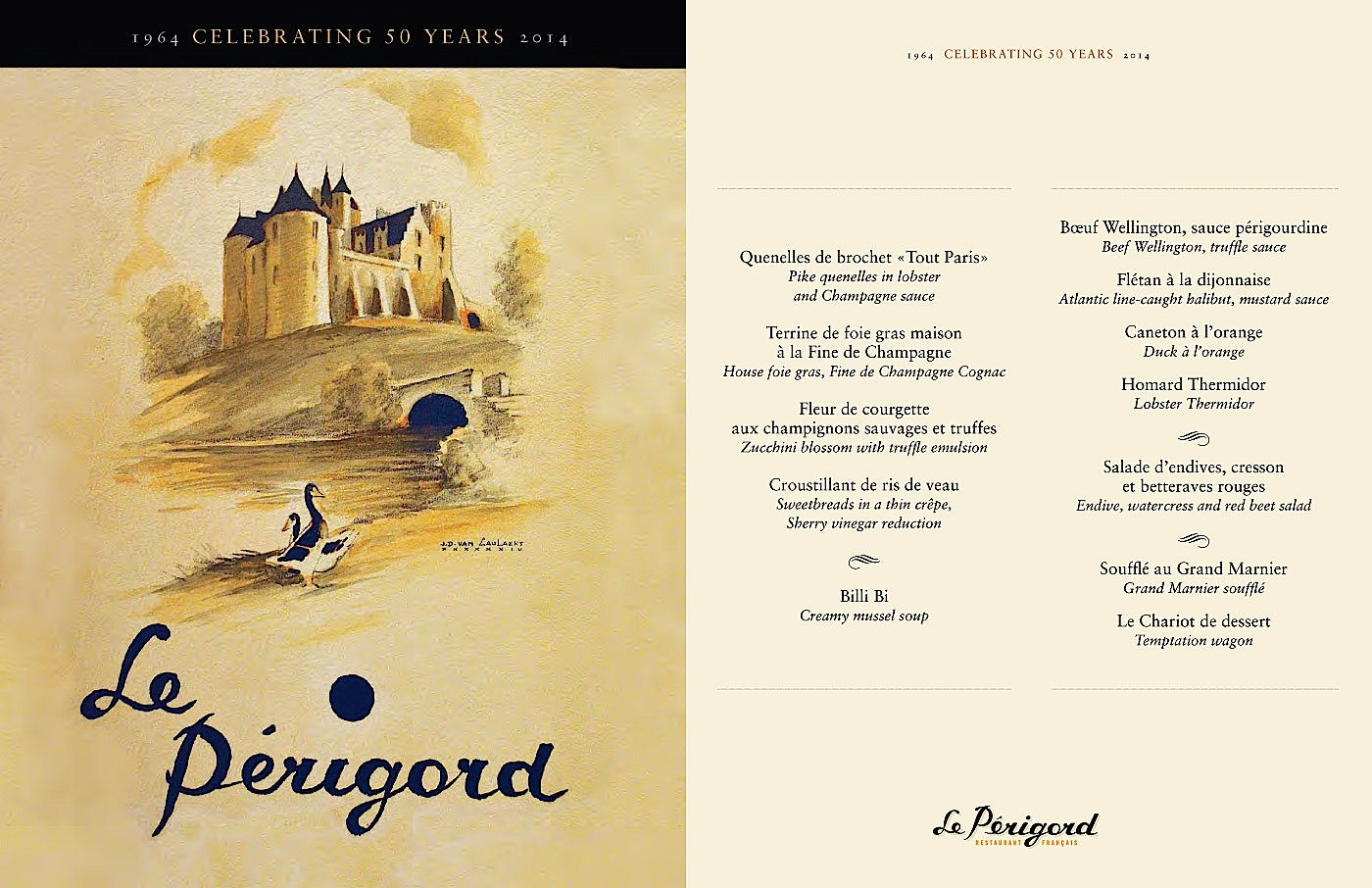 I
have written about Le Périgord several times over
the past four decades—it opened 52 years ago—and I
find that I could pretty much reprint what I said
four years ago or ten years ago about this great
bastion of French cuisine in NYC, whose
competitors once numbered a score of such places
with names like Lutèce, La Caravelle, Le Cygne and
Le Pavillon, all long gone. Only the venerable La
Grenouille survives and thrives along with Le
Périgord, leading to the conclusion that such
restaurants are wholly out of fashion.
I
have written about Le Périgord several times over
the past four decades—it opened 52 years ago—and I
find that I could pretty much reprint what I said
four years ago or ten years ago about this great
bastion of French cuisine in NYC, whose
competitors once numbered a score of such places
with names like Lutèce, La Caravelle, Le Cygne and
Le Pavillon, all long gone. Only the venerable La
Grenouille survives and thrives along with Le
Périgord, leading to the conclusion that such
restaurants are wholly out of fashion.
The truth is, those other restaurants—what used to
be called the “Le and La crowd”—closed for various
reasons that range from impossible real estate hikes
(when Le Périgord opened in 1964 its rent was $600 a
month) to the retirement or death of the owners. There is
no question that more modern styles of French
restaurants opened in their wake—Daniel,
Jean-Georges, Le Bernardin—and NYC is still rife
with French bistros like Benoit, Cognac Brasserie
and La Mangeoire, but Le Périgord sails on against
prevailing fashion, and it is as certain that you
will meet owner Georges Briguet today as you would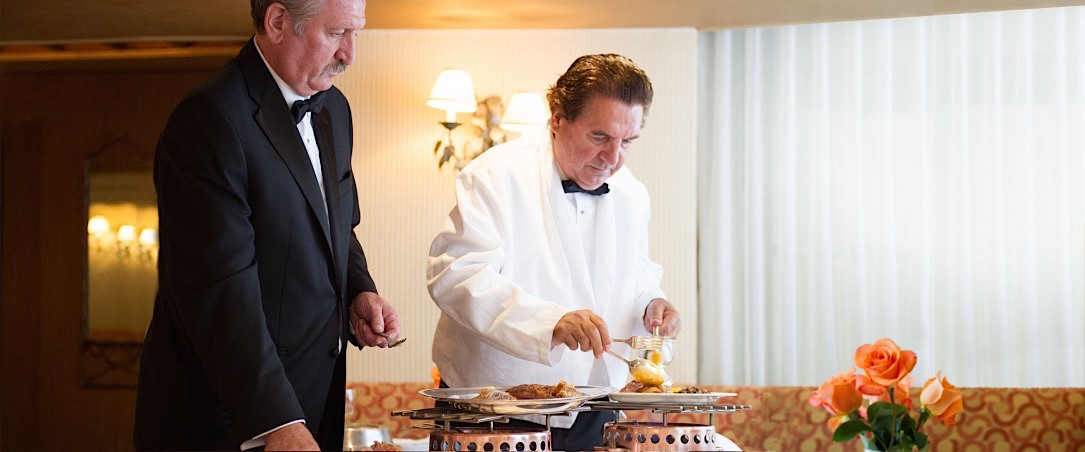 have in 1970, 1980, 1990
or 2000.
have in 1970, 1980, 1990
or 2000.
The word redoubtable seems created to describe
Monsieur Briguet, as affable a Swiss host as you’ll
ever find, ever in a tuxedo and pleated shirt (as
are the captains), smiling broadly and greeting old
and new friends, and always trying to find a way to
make you come back again and again. Joined by
his son, Christopher, Monsieur Briguet now works at
his beloved restaurant simply because he loves it
more than anything in the world, and he gets antsy
when he takes vacations or even days off. Madame
Briguet must be a very understanding woman.
The premises differ
considerably from the dated look of old-line French
restaurants with their scarlet banquettes and
crowded-in tables in a favored front room; instead
the dining room is done in warm tones of gold with
track lights and mirrored columns, with
well-separated tables set with roses, and the
lighting flatters everyone from the front of the
restaurant to the rear and along every wall. There is
a marvelous array of cold hors d’oeuvres (below) as you
enter—from smoked salmon and poached asparagus to
pâtés, terrines, and cold shellfish with mayonnaise
($22)—next to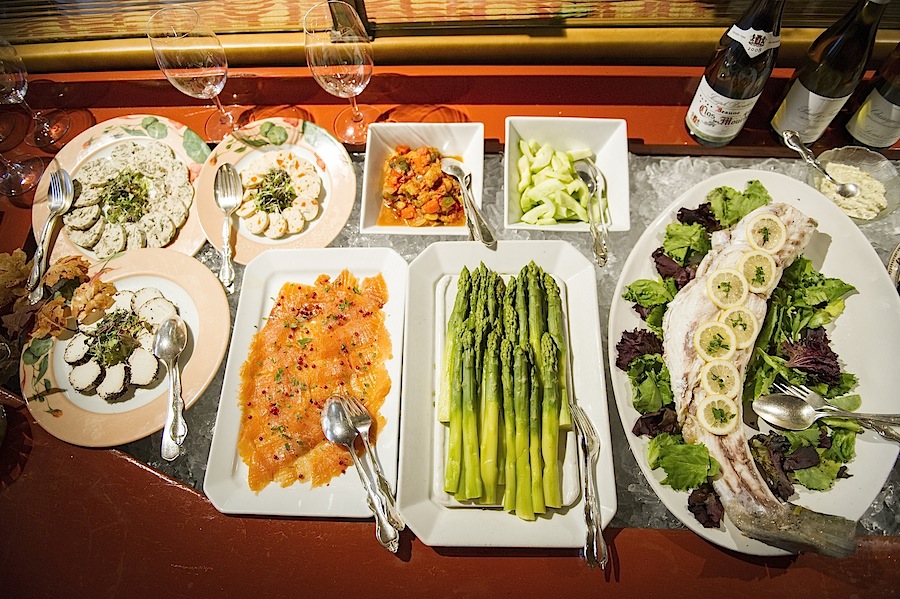 an equally tempting cart
of desserts and a guéridon for carved roasts.
an equally tempting cart
of desserts and a guéridon for carved roasts.
Le Périgord still maintains a clientele from Sutton
Place and the nearby U.N., and on a recent visit a
number of representatives from Singapore dined
happily at a long table in the main dining room,
while a group from Goldman Sachs was in the rear
party room.
You sit down to find the tablecloth thick, the pats
of butter abundant, the bread made in house, the
wine list full of old vintages whose prices haven’t
changed in years, especially the collection of
Burgundies.
Longtime Chef Joel Benjamin has honed every dish on
the menu to rigid classic standards, so recommending
the Dover sole (below)
à la meunière
($50), or the quenelles of pike in sauce Nantua,
is always a sure bet.
Monsieur Briguet insists with total
justification that Benjamin makes the best lobster
bisque ($12) in the city—not too thick with cream,
carefully passed through a sieve, tasting of nothing
but lobster and the faint smokiness of its roasted
shell.
The foie gras, from D’Artagnan, has
a perfect little rind of yellow fat around it and
glistening cubes of Sauternes gelée ($22). Meaty but
tender sweetbreads are dusted with Moroccan harissa and
sweet Bell pepper ($18), while escargots are served
out of their shell, as a fricassee with hazelnut
butter and wild mushrooms ($18). As many
times as you’ll have rack of lamb in NYC, you’ll
rarely find it so perfectly cooked, so perfectly
fatted, and so generously portioned with a fresh
thyme crust as you will here ($46).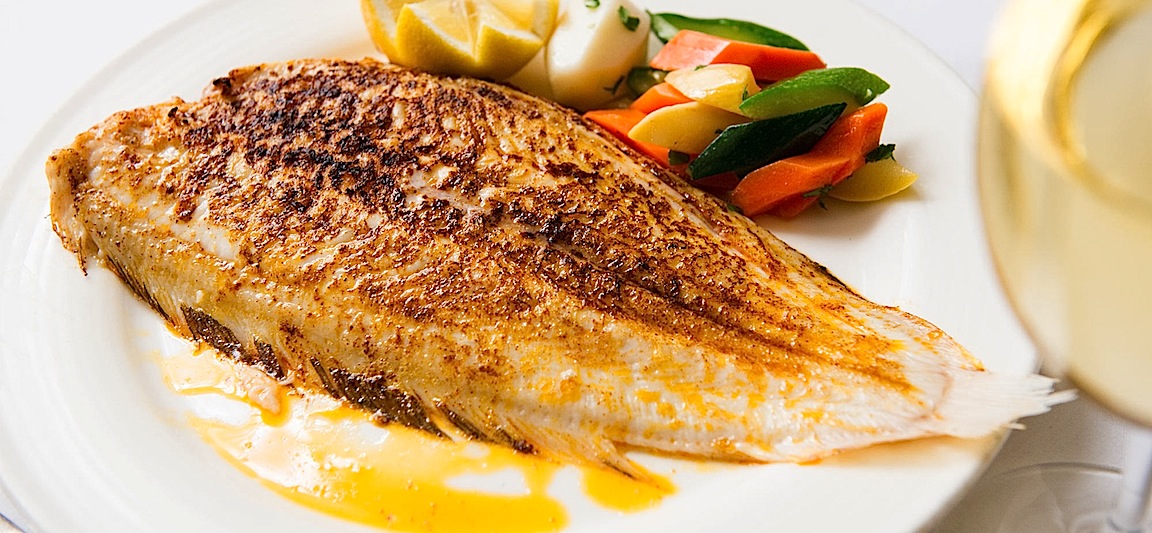
When was the last time you had roast duck ($40), its
skin as crisp as parchment, carved in front of you,
pieces then placed on a warmed plate and drizzled
with an impeccably reduced jus fragrant and sweetened with
orange? This
dish seems to be making a comeback in some quarters
of NYC, but Le Périgord’s version is still far out
ahead.
You must order soufflés ($8) in advance and, whether
chocolate, hazelnut, Grand Marnier, or other, they
will also exhibit how practice makes perfect in the
way they achieve the ideal rise above the rim, the
careful melding of egg whites and flavorings, and
the pour of sauce or ice cream in the steaming
pierced top.
Otherwise you must choose among desserts that
seem to beam at you from their cart—deep dark
chocolate mousse, golden Tarte Tatin, and my
favorite, oeufs
à la neige of 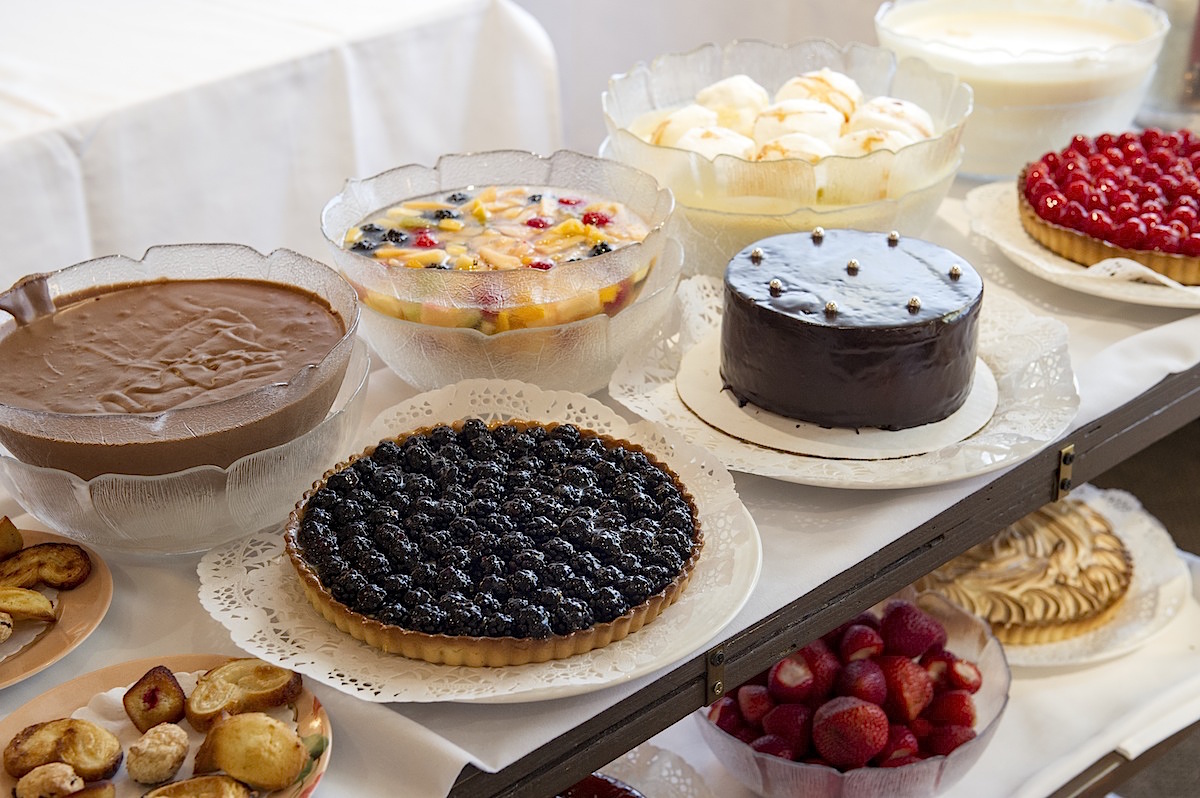 whipped,
cloud-like egg white puffs bathed in crème anglaise. Ten
dollars brings you a selection of several desserts
offered.
whipped,
cloud-like egg white puffs bathed in crème anglaise. Ten
dollars brings you a selection of several desserts
offered.
A prix fixe lunch is just $35 (also à la carte), and
dinner, at $75 (with à la carte options, too), runs
far below La Grenouille’s $138.
One more touch that makes Le Périgord unusual: It’s
open on Sundays for dinner, when many families will
assemble for a fine, restful meal and gracious
hospitality.
Monsieur Briguet always seems
to hint that someone might buy Le Périgord, but it’s
difficult to imagine he would ever give up his labor
of love and more difficult still to imagine Le
Périgord without him.
Le Périgord is open Mon.-Fri. for lunch and
nightly for dinner.
❖❖❖
TOP-NOTCH SICILIAN WINES NOW AVAILABLE
By Geoff Kalish
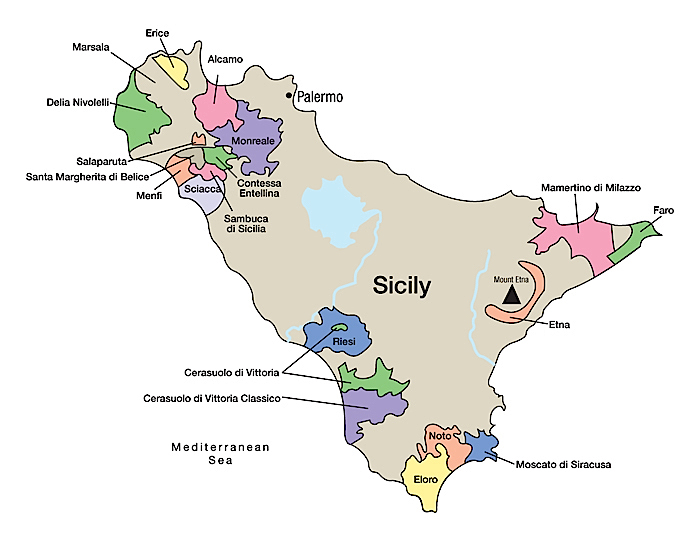
Discovered
in the United States by more than just the
wine cognoscenti, a number of excellent,
sensibly priced Sicilian reds, whites and
rosés are now widely available across the
country. In fact, while just a few
years ago many restaurant wine lists lumped
bottles from Sicily into a “Southern Italian”
grouping or as “other,” these same eateries
now provide far more than meager
selections of vintages in a separate
“Sicilian” category. And retail shops that
once rarely carried more than a token bottle
of Nero d’Avola, now offer shelves devoted to
selections from the island. To gain
insight into what the market has to offer,
the NYC-based Wine Media Guild recently
held a tasting of more than two dozen of these
wines with lunch. The following are which I
thought were the six best.
WHITE
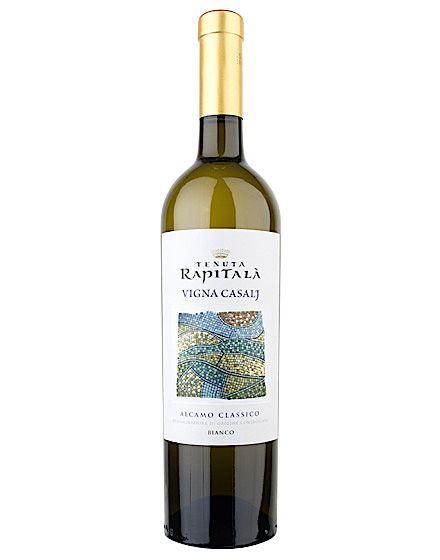 In general,
I’m not a big fan of Italian white wines, feeling
that many of them are very bland, one-dimensional
products made so as not to offend the palate of
even the least discerning consumer. On the other
hand, of the nine whites offered, I found the 2014 Tenuta Rapitala
Vigina Casalj Alcamo Classico DOC ($17)
extremely enjoyable. Made from 100%
Catarratto grapes (the most widely planted white
varietal in Sicily), the wine showed a bouquet and
taste of ripe peaches and pears with undertones of
sage and a crisp finish, perfect to pair with
grilled tuna and pasta with seafood.
In general,
I’m not a big fan of Italian white wines, feeling
that many of them are very bland, one-dimensional
products made so as not to offend the palate of
even the least discerning consumer. On the other
hand, of the nine whites offered, I found the 2014 Tenuta Rapitala
Vigina Casalj Alcamo Classico DOC ($17)
extremely enjoyable. Made from 100%
Catarratto grapes (the most widely planted white
varietal in Sicily), the wine showed a bouquet and
taste of ripe peaches and pears with undertones of
sage and a crisp finish, perfect to pair with
grilled tuna and pasta with seafood.
ROSĖ
With so many too sweet, low-acid rosés (rosati
in Italian) on the market, the 2015 Tasca
d’Almerita Le Rosé di Regaleali Terre
Siciliane ($13) was a welcome find. Made
from 100% Nerello Mascalese grapes, the wine had a
salmon pink color, a fragrant bouquet of ripe
cherries and strawberries, with a fruity taste
that was crisp and dry on the finish. This wine
makes an excellent aperitif, but it also mates
well with salmon or pork.
RED
The four standout reds were from totally different
Sicilian locales. The 2014 Planeta Cerasuolo di Vittoria ($23),
from vineyards outside the town of Vittoria,
showed a bouquet and easy-drinking taste of ripe
plums and apricots, with a long pleasant finish.
This wine goes well with a wide variety of fare
ranging from steak tartare to grilled veal chops
to pasta with red sauce. 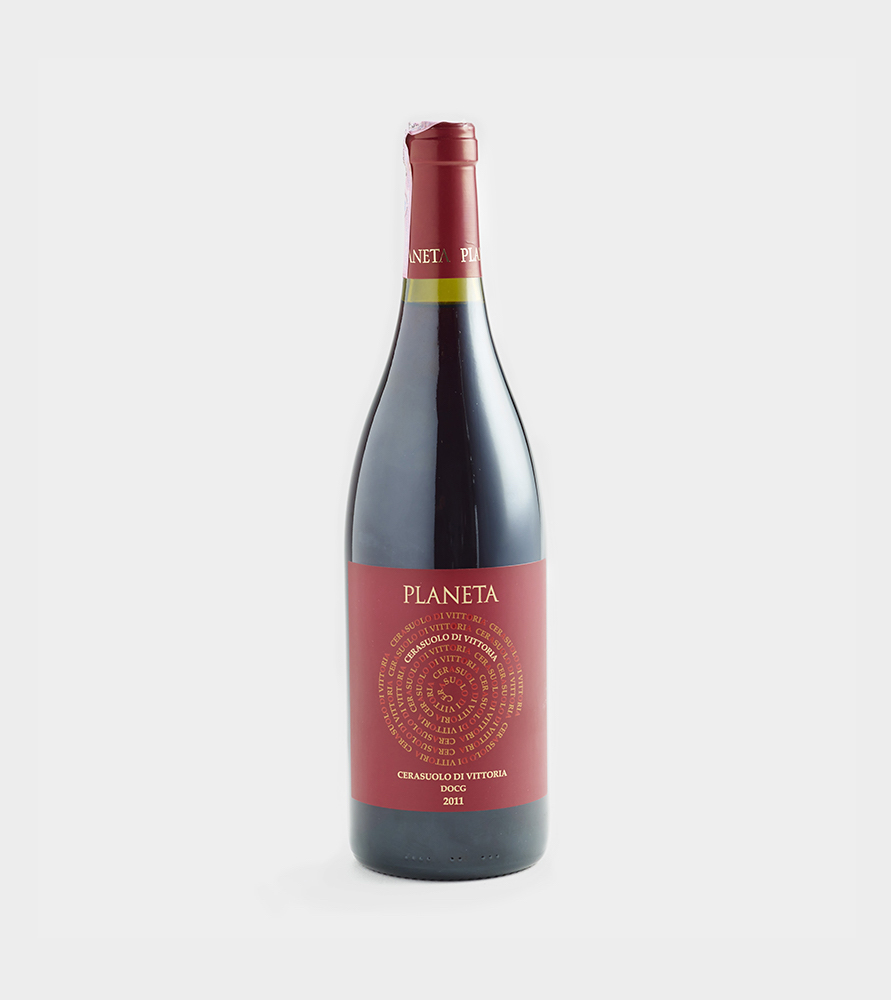
The 2011 Palari Rosso
del Soprano ($59) hailed from the Messina
area and is a blend of primarily Nerello Mascalese
grapes (60%) and smaller amounts of five other
indigenous varietals. Albeit pricy, the wine is
amazingly Burgundian in style with a bouquet and
taste of plums and spice and a bit more oomph than
many reds from the Côte d’Or but not as
overwhelmingly fruity as a number of California
Pinot Noirs. Try it with grilled beef or lamb.
A well priced 2014 Cusumano Nero
D’Avola ($13), from vineyards in San
Giacomo, exhibited a very fruity bouquet and
concentrated taste of ripe blackberries and
raspberries with a long pleasant finish. Pair this
wine with hamburgers or pizza as well as
dark-veined cheeses.
A 2010 Vivera
Etna Rosso “Martinella” ($40), from the
northest side of Mt. Etna —a blend of 80% Nerello
Mascalese and 20% Nerello Cappuccio–-shows the
great aging potential for this category of wine.
It has a bouquet and soft taste of plums and
strawberries interlaced with exotic spices and a
smooth finish with a touch of tannin. Mate this
wine with grilled pork chops, ripe cheeses or rich
pasta Norma.
And those
consumers who view Marsala as merely a cooking
wine should try the Florio Targa Riserva Marsala Superiore
Riserva Semisecco ($35 for a 500ml
bottle) for a rich, sweet treat with flavors of
dried figs and apricots and a vibrant acidity in
the finish to enjoy with chocolate or mild
cheeses.
❖❖❖
According to a Google study/survey, here are the foods
that are "risers" and "decliners" for those who give a
damn.

RISERS
Rigatoni
Bibimbap
Uncured Bacon
Bundt Cakes 
Overnight Oats
Smash Cake
Gender Reveal Cake
Funfetti
Vegan Donuts
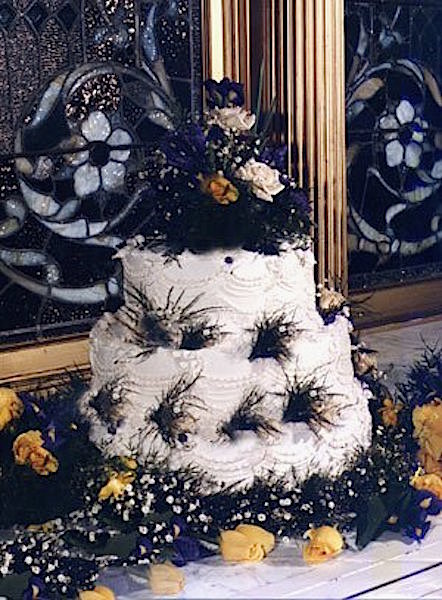 DECLINERS
DECLINERSGluten
Free Cupcakes
Evaporated Cane Juice
Wedding Cakes
Rainbow Bagels 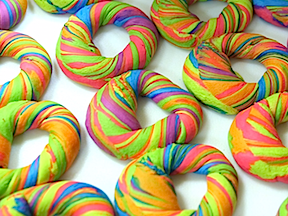
Dutch
Baby Pancake
Mulligan Stew
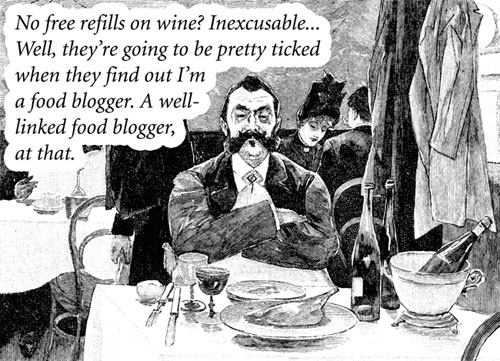
"TARGET MAY BE WEARING DARK
SUNGLASSES, CARRYING A SPIRAL
NOTEPAD AND HAVE GARLIC BREATH."
According to The
Economist, it is not easy being the only
restaurant critic in Baghdad. “Before when I wrote, I
would say when something is bad,” says Anas al-Sarraf,
founder of the online Baghdad
Restaurant Guide. “But I stopped six months ago
because I got a lot of threats. Someone who is spending
$2m to open a restaurant can spend $5,000 to order a hit
on me.” At a restaurant in Baghdad’s Sadr
City, he once found himself surrounded by security
people and had to convince them he was taking photos for
a review, not to plan an attack.
Any of John Mariani's books below may be ordered from amazon.com.
 The
Hound in Heaven (21st Century Lion Books)
is a novella, and for anyone who loves dogs,
Christmas, romance, inspiration, even the supernatural, I
hope you'll find this to be a treasured favorite.
The story concerns how, after a New England teacher,
his wife and their two daughters adopt a stray puppy found
in their barn in northern Maine, their lives seem full of
promise. But when tragedy strikes, their wonderful dog
Lazarus and the spirit of Christmas are the only things
that may bring his master back from the edge of
despair.
The
Hound in Heaven (21st Century Lion Books)
is a novella, and for anyone who loves dogs,
Christmas, romance, inspiration, even the supernatural, I
hope you'll find this to be a treasured favorite.
The story concerns how, after a New England teacher,
his wife and their two daughters adopt a stray puppy found
in their barn in northern Maine, their lives seem full of
promise. But when tragedy strikes, their wonderful dog
Lazarus and the spirit of Christmas are the only things
that may bring his master back from the edge of
despair. WATCH THE VIDEO!
“What a huge surprise turn this story took! I was completely stunned! I truly enjoyed this book and its message.” – Actress Ali MacGraw
“He had me at Page One. The amount of heart, human insight, soul searching, and deft literary strength that John Mariani pours into this airtight novella is vertigo-inducing. Perhaps ‘wow’ would be the best comment.” – James Dalessandro, author of Bohemian Heart and 1906.
“John Mariani’s Hound in Heaven starts with a well-painted portrayal of an American family, along with the requisite dog. A surprise event flips the action of the novel and captures us for a voyage leading to a hopeful and heart-warming message. A page turning, one sitting read, it’s the perfect antidote for the winter and promotion of holiday celebration.” – Ann Pearlman, author of The Christmas Cookie Club and A Gift for my Sister.
“John Mariani’s concise, achingly beautiful novella pulls a literary rabbit out of a hat – a mash-up of the cosmic and the intimate, the tragic and the heart-warming – a Christmas tale for all ages, and all faiths. Read it to your children, read it to yourself… but read it. Early and often. Highly recommended.” – Jay Bonansinga, New York Times bestselling author of Pinkerton’s War, The Sinking of The Eastland, and The Walking Dead: The Road To Woodbury.
“Amazing things happen when you open your heart to an animal. The Hound in Heaven delivers a powerful story of healing that is forged in the spiritual relationship between a man and his best friend. The book brings a message of hope that can enrich our images of family, love, and loss.” – Dr. Barbara Royal, author of The Royal Treatment.
 |
The Encyclopedia of American Food and Drink by John F. Mariani (Bloomsbury USA, $35) Modesty forbids me to praise my own new book, but let me proudly say that it is an extensive revision of the 4th edition that appeared more than a decade ago, before locavores, molecular cuisine, modernist cuisine, the Food Network and so much more, now included. Word origins have been completely updated, as have per capita consumption and production stats. Most important, for the first time since publication in the 1980s, the book includes more than 100 biographies of Americans who have changed the way we cook, eat and drink -- from Fannie Farmer and Julia Child to Robert Mondavi and Thomas Keller. "This book is amazing! It has entries for everything from `abalone' to `zwieback,' plus more than 500 recipes for classic American dishes and drinks."--Devra First, The Boston Globe. "Much needed in any kitchen library."--Bon Appetit. |
"Eating Italian will never be the same after reading John Mariani's entertaining and savory gastronomical history of the cuisine of Italy and how it won over appetites worldwide. . . . This book is such a tasteful narrative that it will literally make you hungry for Italian food and arouse your appetite for gastronomical history."--Don Oldenburg, USA Today. "Italian
restaurants--some good, some glitzy--far
outnumber their French rivals. Many of
these establishments are zestfully described
in How Italian Food Conquered the World, an
entertaining and fact-filled chronicle by
food-and-wine correspondent John F.
Mariani."--Aram Bakshian Jr., Wall Street
Journal.
"Equal parts
history, sociology, gastronomy, and just
plain fun, How Italian Food Conquered the
World tells the captivating and delicious
story of the (let's face it) everybody's
favorite cuisine with clarity, verve and
more than one surprise."--Colman Andrews,
editorial director of The Daily
Meal.com. "A fantastic and fascinating
read, covering everything from the influence
of Venice's spice trade to the impact of
Italian immigrants in America and the
evolution of alta cucina. This book will
serve as a terrific resource to anyone
interested in the real story of Italian
food."--Mary Ann Esposito, host of PBS-TV's
Ciao
Italia. "John Mariani has written the
definitive history of how Italians won their
way into our hearts, minds, and
stomachs. It's a story of pleasure over
pomp and taste over technique."--Danny Meyer,
owner of NYC restaurants Union Square
Cafe, The Modern, and Maialino.
|
 |
 |
 |
 |
 |
 |
 |
 |
 Everett Potter's Travel Report:
Everett Potter's Travel Report: 
 Eating Las Vegas
JOHN CURTAS has been covering the Las Vegas
food and restaurant scene since 1995. He is
the co-author of EATING LAS VEGAS – The 50
Essential Restaurants (the fourth
edition of which will be published in early
2016), as well as the author of the Eating Las
Vegas web site: www.eatinglasvegas.
He can also be seen every Friday morning as
the “resident foodie” for Wake Up With the
Wagners on KSNV TV (NBC) Channel 3 in
Las Vegas.
Eating Las Vegas
JOHN CURTAS has been covering the Las Vegas
food and restaurant scene since 1995. He is
the co-author of EATING LAS VEGAS – The 50
Essential Restaurants (the fourth
edition of which will be published in early
2016), as well as the author of the Eating Las
Vegas web site: www.eatinglasvegas.
He can also be seen every Friday morning as
the “resident foodie” for Wake Up With the
Wagners on KSNV TV (NBC) Channel 3 in
Las Vegas.

MARIANI'S VIRTUAL GOURMET
NEWSLETTER is published weekly. Editor/Publisher: John
Mariani.
Editor: Walter Bagley. Contributing Writers: Christopher Mariani,
Robert Mariani, Misha
Mariani,
John A. Curtas, Edward Brivio, Mort Hochstein,
Andrew Chalk, Dotty Griffith and Brian Freedman. Contributing
Photographers: Galina Dargery, Bobby
Pirillo. Technical Advisor: Gerry McLoughlin.
To un-subscribe from this newsletter,click here.
© copyright John Mariani 2016

